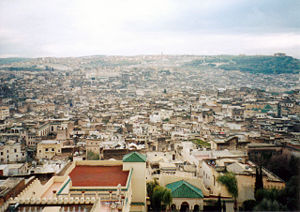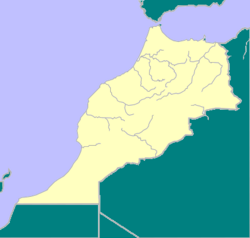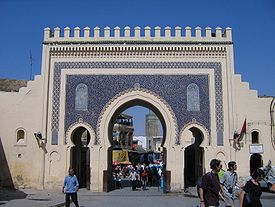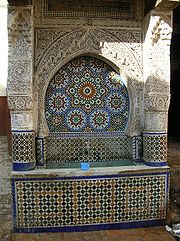Fes, Morocco
| Fes فاس Fās |
|
 |
|
 Fes
|
|
| Coordinates: | |
| Country | |
|---|---|
| Region | Fès-Boulemane |
| Population (2004) | |
| - Total | 946,815 |


Fes or Fez (Arabic: فاس [Fās], French: Fès) is the fourth largest city in Morocco, after Casablanca, Rabat and Marrakech with a population of 946,815 (2004 census). It is the capital of the Fès-Boulemane Region.
Fes is one of the four so-called "imperial cities" (the others are Marrakech, Meknes and Rabat). It is separated into three parts, Fes el Bali (the old, walled city), Fes-Jdid (new Fes, home of the Mellah), and the Ville Nouvelle (the French-created, newest section of Fes). The Medina of Fes el Bali, the largest of the two medinas of Fes, is believed to be the largest contiguous car-free urban area in the world. Fes el Bali is classified as a UNESCO World Heritage Site. The University of Al-Karaouine was founded in 859 A.D. and is the oldest continuous operating university in the world.
Contents |
History
The city was founded on opposite banks of the Fez River by Idris I in 789[1] and his son Idris II continued the work in 810.[2] The first was the founder of the Idrisid dynasty, his son was born after he was assassinated. During Yahya ibn Muhammad's rule the Kairouyine mosque, one of the oldest and largest in Africa, was built, and the associated University of Al-Karaouine was founded in 859.[3] Arab emigration to Fes, mostly from Al-Andalus after a rebellion which took place in Córdoba in 818 and from Tunisia after another rebellion that took place in 824, gave the city a definite Arab character. 'Adwat Al-Andalus and 'Adwat al-Qarawiyyin, the two main quarters of Fes, were called respectively after the two waves of Arab immigrants to the new city.[4] After Ali ibn Umar (Ali II) came to power, the tribes of Madyuna, Gayatha and Miknasa, which were Sufrite Kharijites, formed a common front against the Idrisid and defeated Ali's armies and occupied Fes. Yahya ibn Al-Qassim, drove the Sufrites out of the city and declared himself Ali's successor.[5]
The city was populated by Muslims from elsewhere in North Africa, the Middle East, Moriscos, as well as many Jews, who had their own quarter, or Mellah, in the city.
Almohad dynasty (1130-1269)
- It is believed that Fes was the largest city in the world from 1170 to 1180.[6]
Fes became the scientific and religious center, where both Muslims and Christians from Europe came to study.
Marinid dynasty (1269-1420)
Kingdom of Fez (1420-1554)
- Many Muslim refugees came to Fes after the reconquest of Spain in 1492.
Saadi dynasty (1554-1603)
- Partition
Capital of Saadi Kingdom of Fez (1603-1627)
Later became part of Saadi Dynasty (1627-1649)
Fes became the center of the Morocco in 1649, and it was a major trading post of the Barbary Coast of North Africa. Until the 19th century it was the only source of Fez hats (also known as the tarboosh), before they began to be manufactured in France and Turkey; originally, the dye for the hats came from a berry that was grown outside the city, known as the Turkish kizziljiek or Greek akenia (Cornus mascula). Fes was also the end of a north-south gold trading route from Timbuktu.
It became independent in 1790–1795, under the leadership of Yazid in 1790-1792, and later, of Abu´r-Rabi Sulayman in 1792-1795. This Kingdom was conquered by Morocco.
In 1819–1821 was part of the rebellion whose leader was Ibrahim ibn Yazid. In 1832 rebellion, leader Muhammad ibn Tayyib.
Fez was a prime manufacturing location for leather goods such as the Adarga.
Fes has been the capital of Morocco several times in the past, the last of which ended in 1912, when most of Morocco came under French control and Rabat was chosen to be the capital of the new colony, a status retained even when Morocco achieved independence in 1956. While many of the original inhabitants of Fes have since emigrated, the Jewish quarter has been emptied of its Jewish population (In 1465, there was large massacre of Jews by Arab riots. [7]), and the economy has stagnated, Fes is perhaps the most interesting and picturesque of the Imperial Cities of Morocco. Despite the traditional character of most of the city, there is also a modern section, the Ville Nouvelle, or "New City", which is a bustling commercial center. The popularity of the city has increased since the King of Morocco took a Fassi computer engineer, Salma Bennani, as his wife.
Tourism

Fes is becoming an increasingly popular tourist destination and many non-Moroccans are now restoring traditional houses (riads and dars) as second homes in the Fes medina. The most important monuments in the city are:
- Bou Inania Madrasa
- Al-Attarine Madrasa
- University of Al-Karaouine
- Zaouia Moulay Idriss II
- Dar Batha
Transport
The city is served by Saïss Airport. It also has an ONCF train station which goes east to Oujda and west to Tanger and Casablanca [1].
Twin towns - Sister cities
Fes is twinned with:
|
|
Sister cities:
Footnotes
- ↑ Jewish and Muslim Dialects of Moroccan Arabic By Jeffrey M Heath. p. 23.
- ↑ Fes." Encyclopædia Britannica. 2007. Britannica Concise Encyclopedia. 3 Mar. 2007
- ↑ Merriam Webster's Collegiate Encyclopedia. p.574.
- ↑ A History of the Maghrib in the Islamic Period By Jamil Mir'i Abun-Nasr. p. 51.
- ↑ A History of the Maghrib in the Islamic Period By Jamil Mir'i Abun-Nasr. p. 52.
- ↑ Largest Cities Through History
- ↑ Norman Stillman, The Jews of Arab Lands, 1979, pages 59, 284.
- ↑ The twinning was signed with the Palestinian Authority between Fes and Al-Quds. Morocco does not officially recognize Israel.
- ↑ "Kraków official website - Partnership Cities".




 (in English, German, French, Chinese and Polish) © 1996-2008 ACK CYFRONET AGH. Retrieved on 2008-11-01.
(in English, German, French, Chinese and Polish) © 1996-2008 ACK CYFRONET AGH. Retrieved on 2008-11-01. - ↑ "Sister cities of İzmir (1/7)" (in Turkish). Retrieved on 2008-11-01.
See also
- Treaty of Fez
- Book by Roger Le Tourneau (English translation by Besse Clement), Fez in the Age of the Marinides, Oklahoma University, editions 1961 and 1974 (latter ISBN 0806111984).
External links
- Fes travel guide from Wikitravel
- complexe culturel de fes complexe culturel de fes, Morocco
- Fez City of Islam
- Fantastic Morocco A practical travel guide to Fes, Morocco
- Best of Morocco An accommodation guide to Fes, Morocco
- The portal of Fès
- In Search of the Sacred at the Fez Festival, Part 1 An in depth review of the Fez Festival Of World Sacred Music.
- In Search of the Sacred at the Fez Festival, Part 2
- Fes, Morocco is at coordinates
- Pictures and videos from Fes and Morocco
| Preceded by Aleppo |
Capital of islamic culture 2007 |
Succeeded by Alexandria, Djibouti, Lahore |
|
|||||||